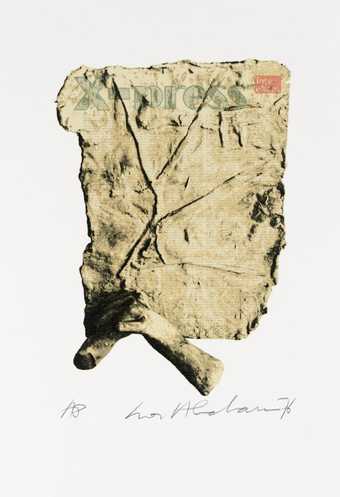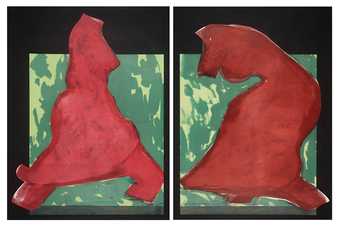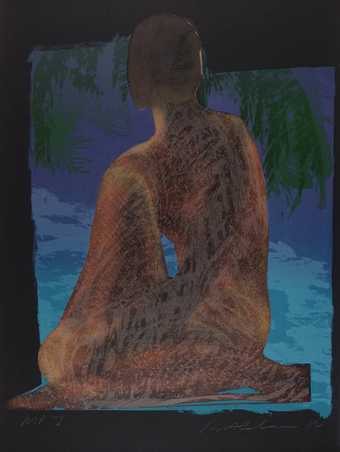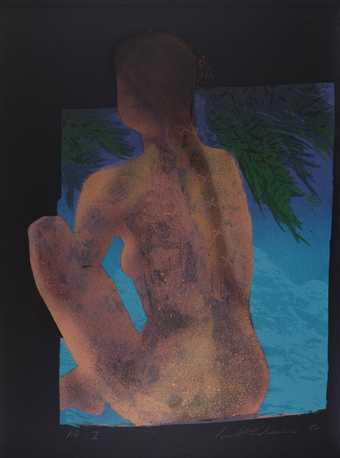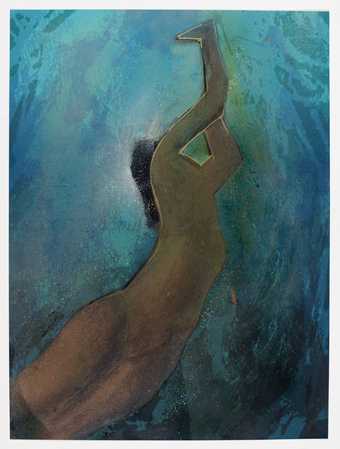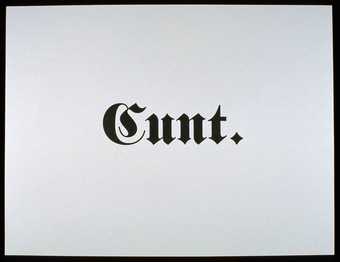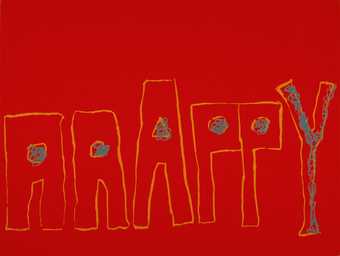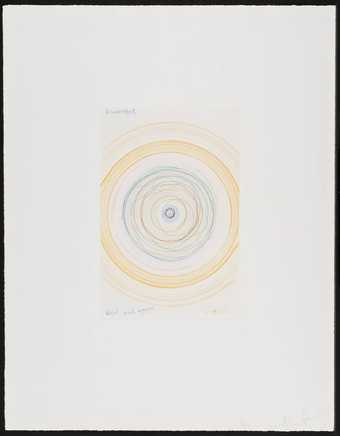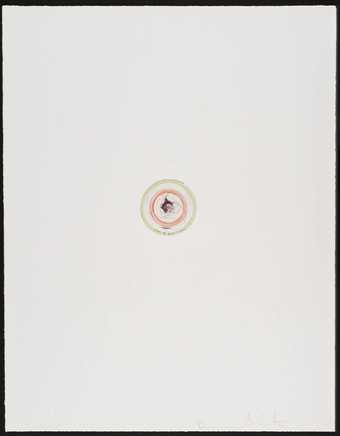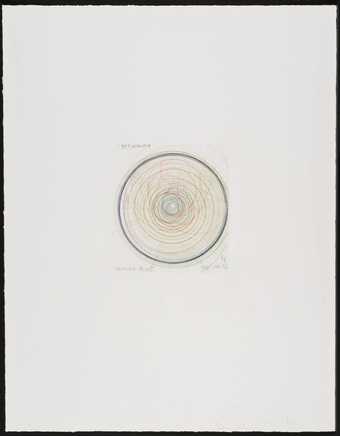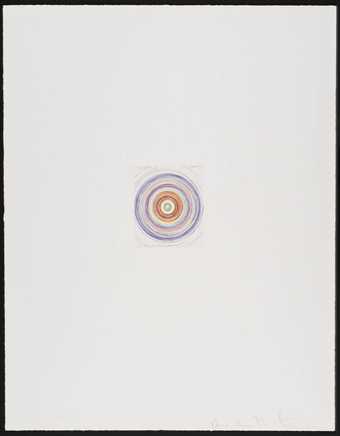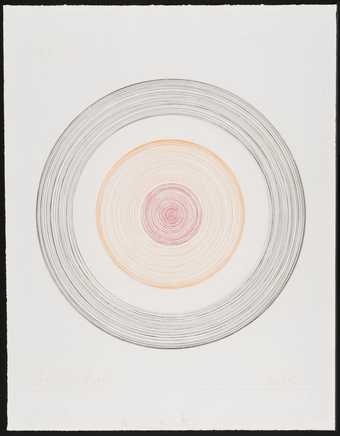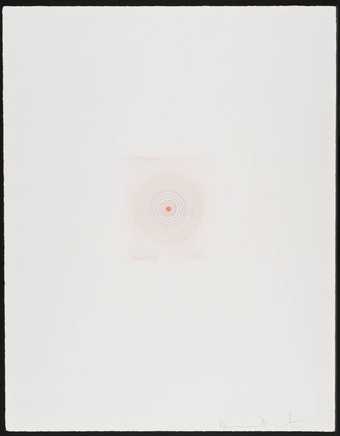
In Tate Britain
Prints and Drawings Room
View by appointment- Artist
- Darren Almond born 1971
- Part of
- Screen
- Medium
- Screenprint on paper
- Dimensions
- Image: 731 × 889 mm
- Collection
- Tate
- Acquisition
- Purchased 1998
- Reference
- P78078
Summary
Multiple Working 1997 is a screenprint on white wove paper depicting an embossed plate bearing the full name of the British artist Darren Almond. The rectangular plate, which appears on a plain background, is made of cast aluminum metal and is painted bright red with the exception of ten small screws located around its edges and the silver embossed letters of the artist’s name. The print is signed by the artist on its reverse.
This work was made by Almond in London in 1997. It is closely related to his sculpture Intercity 125 1997, for which the artist commissioned British Rail to make a plate featuring his full name in the same typeface used for plaques appearing on the exterior of InterCity 125 trains. The sculpture was the first work Almond completed in an ongoing series entitled Trainplates, in which phrases appear in various fonts used by British Rail in their classification system. ‘Multiple working’ is a term that describes trains, such as the InterCity 125, that have more than one locomotive coupled together and controlled by a single driver. Almond’s adoption of the term for the title of this work can also be seen as a reference to the screenprint’s multiple editions.
A particular interest in trains is evident across a range of Almond’s works, as part of the artist’s broader fascination with movement, travel and forms of transport. For instance, Schwebebahn 1995 is a single-channel film depicting the eponymous monorail train system in the German city of Wuppertal, while In The Between 2006 is a three-channel colour video that explores the political implications of the high-speed train line that joins China and Tibet. In a 2002 interview, Almond discussed his interest in train travel in relation to his childhood growing up near the British city of Wigan:
I’ve done a lot of travelling and psychologically I need that attachment to keep focused. But there is also a need to make yourself vulnerable through travel and exposure to different cultures. That was very much tied up with the notion of being a trainspotter as a kid: I am going to do something that nobody knows I am doing and I am going to get out of here and see something along the way.
(Quoted in John Slyce, ‘Darren Almond: Transport Medium’, Flash Art, vol.34, no.222, January–February 2002, pp.71–2.)
In 1998 the curator Kate Bush claimed that the sculpture Intercity 125 ‘summons every trainspotter’s wishful dream, the endless pleasures of speed and unknown places’ (Bush 1998, p.73).
In immortalising the artist’s name on a plaque, Intercity 125 and Multiple Working may be viewed as comic and self-conscious statements by Almond regarding his status at an early stage of his career. In this respect, these works may be compared with Cavey 1991–7 (Tate T13208), a sculpture by the contemporaneous British artist Gavin Turk which consists of a blue plaque bearing Turk’s name that mimics the format employed to celebrate historic figures in locations across the UK.
Almond, who studied at Winchester School of Art (1990–3), has explored both personal and social approaches to history, memory and time. Between 1997 and 2007 he made a series of works involving bus shelters from the Polish town of Oswiecim, formerly home to the Auschwitz concentration camp during the Second World War. Almond’s three-screen video installation Traction 1999 includes an interview with his father about the injuries he sustained at work alongside footage of his mother’s reaction, while If I Had You 2003, a four-screen video installation featuring footage shot in Blackpool, focuses on his grandmother’s memories of her marriage.
Multiple Working is part of Screen, a portfolio of eleven prints by London-based artists that was published in 1997 by Charles Booth-Clibborn under his imprint The Paragon Press. The works were all made between February and July 1997, and are presented together with a title page and colophon by the graphic designer Phil Baines in a black buckram-covered wooden case. The title of the portfolio refers to the technique of screenprinting and also alludes to the fact that many of the featured artists work with screen-based media. Each print exists in an edition of seventy-five, with the first forty-five produced in portfolio sets, of which the portfolio owned by Tate is number thirty-three.
Further reading
Kate Bush, ‘Doing Time’, Frieze, no.42, September–October 1998, pp.72–5.
In Print: Contemporary British Art from the Paragon Press, exhibition catalogue, Cvijeta Zuzoric Art Pavilion, Belgrade, London 2001, p.21.
Ziba de Weck Ardalan (ed.), Darren Almond: Index, London 2008, p.138.
Richard Martin
October 2015
Supported by Christie’s.
Does this text contain inaccurate information or language that you feel we should improve or change? We would like to hear from you.
Explore
- abstraction(8,615)
-
- non-representational(6,161)
-
- text(1,043)
- inscriptions(6,664)
-
- name of artist(199)
You might like
-
Norman Dilworth Rational Concepts
1977 -
Ivor Abrahams The Masque of the Red Death
1976 -
Ivor Abrahams Xing a Paragrab
1976 -
Ivor Abrahams Diptych
1981 -
Ivor Abrahams Vahine I
1984 -
Ivor Abrahams Vahine II
1984 -
Ivor Abrahams Nereids II
1986 -
Sam Taylor-Johnson OBE [no title]
1994 -
Gary Hume [no title]
1994 -
Damien Hirst Wheel meet again
2002 -
Damien Hirst Ring-a-ring of roses
2002 -
Damien Hirst I get around
2002 -
Damien Hirst Like a snowball down a mountain
2002 -
Damien Hirst Orbital
2002 -
Damien Hirst Spinning wheel
2002



